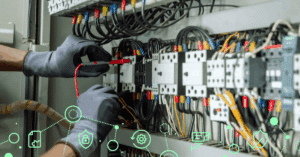Why It’s Critical to Mitigate the Risk of Device Sprawl

It’s a universally accepted truth that the internet of things (IoT) is a part of the modern world. There are millions of such devices brought online every day for both enterprises and consumers, including internet-enabled coffee makers, refrigerators, doorbells, security cameras, temperature monitors, and much more. Some estimates place the number of IoT devices currently online at more than 15 billion worldwide, with that amount expected to double by 2030.
This number of IoT devices in use creates a new problem: device sprawl. Companies are implementing more connected equipment in their infrastructure, such as printers, environment sensors, and smart TVs. As more devices are added to corporate networks to solve a particular problem, cybersecurity teams are faced with the challenge of mitigating the risk that this connected equipment presents.
The security risk that IoT device sprawl presents is substantial. The reasons include the increased attack surface that connected equipment creates, the difficulty of patching IoT devices, and the challenge of building a complete inventory.
IoT Device Sprawl Means a Bigger Attack Surface
One of the biggest challenges in modern cybersecurity is a growing attack surface. More internet-connected hardware and software assets in the modern enterprise means that there are more possible footholds for attackers. Already the average attack surface is growing 133% year over year, according to research, and this growth is unlikely to abate any time soon.
IoT devices add yet more internet-connected assets to networks that are already overwhelmed with cloud services and other network-accessible software and hardware. IoT device sprawl contributes to this growing attack surface, further complicating understanding the scope of exposed assets in an organization’s architecture. Each new internet-enabled device placed in a distributed location that has to send information back to a central database means one more potential access point for threat actors.
IoT devices such as cash registers in retail stores or environment sensors in manufacturing plants that send information over the internet expose the organization to risk. The traffic they communicate back to the corporate data center may or may not be encrypted, and they may also be accessible to suppliers for reasons of remote maintenance or performance monitoring. IoT device sprawl can thus contribute to the scale of the problem with externally-facing assets.
These IoT devices create a borderless environment, shattering traditional security concepts built around perimeter protection for the entire corporate network. IoT exists outside the standard network concept in many cases, especially for geographically remote equipment used for things like weather monitoring and more. This new paradigm of technology usage means an even more volatile attack surface and requires the use of a scanning solution to fully understand the communication patterns of these systems.
Only through continuous discovery and inventory management is it possible for security teams to maintain the full picture of IoT devices deployed in the organization. Once those devices are known, however, the next problem is vulnerability management.
IoT Device Sprawl Complicates Vulnerability Management
Vulnerability management and a solid patching strategy are two of the hallmarks of good security strategy. Patching is especially difficult with IoT devices for a few reasons, but it is enormously valuable to overall security strategy. A lot of IoT equipment is shipped with outdated operating systems designed explicitly for fixed-function devices, but with security vulnerabilities in place right away.
Among the reasons patching in IoT is difficult are:
- Lack of user interface – Many IoT devices lack a user interface for technicians to interact with. This complicates deploying patches, even if one would be available for the device in question.
- Unknown impact of an update – In most cases, there’s no way of telling if an IoT device is even able to accept a patch or what the impact of that patch could be. The IoT device could go permanently offline or cause operational challenges if the patch isn’t accepted.
- Inability to take offline for resolution – A lot of IoT devices are too critical for technicians to take them offline for patching. Think of pacemakers in cardiology patients or temperature sensors that have to remain online at all times. Technicians can’t take devices like those offline, no matter how vital the software patch is.
- Potential lack of vendor support – If vendors go out of business or stop supporting a particular IoT device, organizations could be left insecure. There’s no telling if or when that end of life will occur for connected equipment.
The borderless environment that IoT device sprawl creates is enormously complicated at the best of times. Managing vulnerability remediation in this situation adds yet another dimension to the difficulty of using connected equipment.
How Asimily Can Help Manage IoT Device Sprawl
The Asimily platform is designed to mitigate the challenges of IoT device sprawl. Built with the modern enterprise in mind, Asimily’s solution is meant to empower security teams with the intelligence and detection technology that helps them make better decisions. Asimily does this with several capabilities, including:
- Inventory creation – Keep an accurate inventory of current and new devices, using safe, passive traffic monitoring. Devices are classified and metadata about the device is also available. IoT device sprawl requires regular discovery, and Asimily is constantly discovering.
- Anomaly detection – Asimily leverages powerful traffic analysis and deep packet inspection to investigate IoT behavior at scale. This allows Asimily to find and surface anomalous behavior in IoT devices so security teams can quickly discover any issues in their network.
- Vulnerability mitigation – Deep device-specific analysis for each vulnerability gets to the heart of risk, not stopping at counting vulnerabilities. Reduce risks with less work. Asimily’s solution builds a complete picture of device vulnerabilities, helping security teams prioritize their risks.
Asimily is built to help organizations resolve their IoT security challenges through effective inventory creation and anomaly detection, among other capabilities. With Asimily, companies suffering from IoT device sprawl can begin to take control of their infrastructure. The borderless environment of modern enterprises that use IoT need a new strategy. Asimily’s security solution can make that happen.
To learn more about Asimily, download our Total Cost of Ownership Analysis on Connected Device Cybersecurity Risk whitepaper or contact us today.
Reduce Vulnerabilities 10x Faster with Half the Resources
Find out how our innovative risk remediation platform can help keep your organization’s resources safe, users protected, and IoT and IoMT assets secure.




